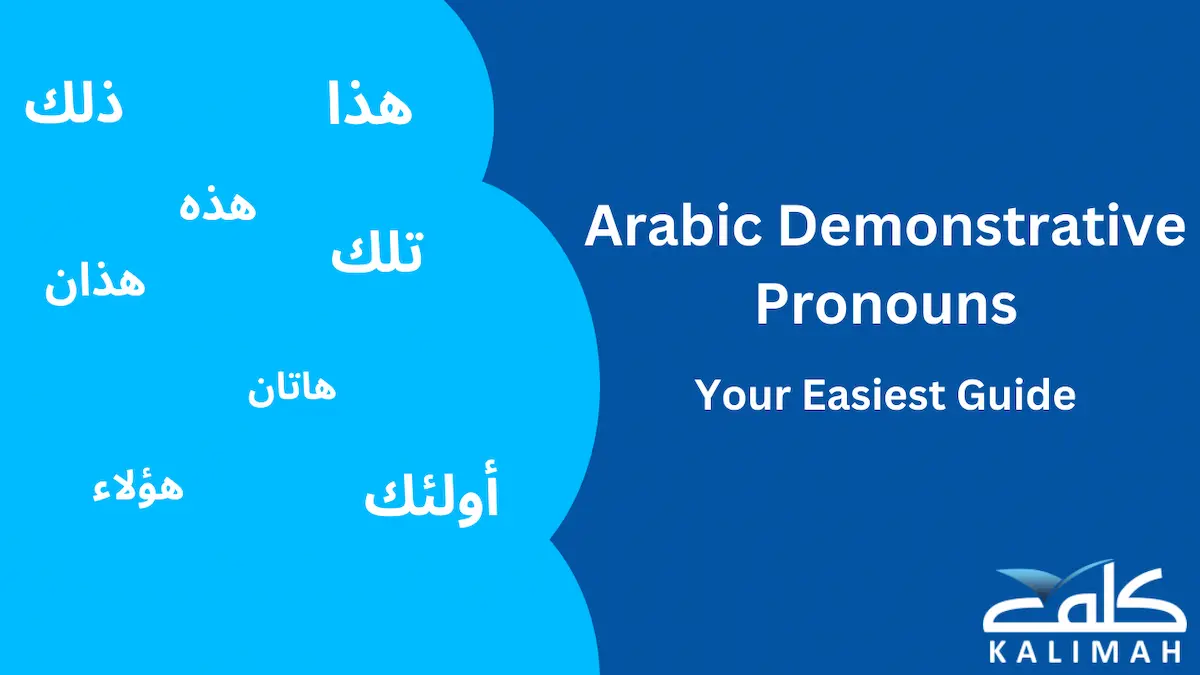To master any language you have to master its articles, prepositions, determines, pronouns, and so on…
In this article, we are going to explain the Arabic demonstrative pronouns, their definitions, functions, their singular and plural forms, their masculine and feminine forms, and the similarities and differences between them. We will provide examples of demonstrative pronouns in a simple way that helps you form Arabic sentences efficiently. Keep reading
What do Arabic Demonstrative Pronouns Mean?
Arabic demonstrative pronoun is an article that comes before a noun. Its main use is to refer to a specific thing or definite person whether it is singular, dual (Muthanna), plural, masculine, feminine, and near or remote. The function of the demonstrative pronouns is to put stress or draw attention to the nouns following them. They refer to the relative interval or remoteness of the noun being referred to, they also are used to refer to sequent and subsequent order. They are known in Arabic grammar terms with the name, Asma’a El- Esharah
The equivalent English pronouns to the Arabic demonstrative pronouns are:
This = هذا/ هذه
That = ذلك / تلك
These = هذان / هاتان / هؤلاء
Those = هذان/ هاتان / أولئك
What Are All the Demonstrative Pronouns?
Here are the Arabic demonstrative pronouns with a brief explanation of their definitions and functions:-
| هذا | هذان | ذلك | هؤلاء |
| هذه | هاتان | تلك | أولئك |
Using a demonstrative pronoun in a phrase or a sentence depends on the noun that follows it. Some demonstrative pronouns are used for singular nouns, others are used for plural nouns. On the other hand, there are demonstrative pronouns that are used for masculine nouns and others for feminine nouns. It is worth mentioning that the demonstrative pronouns care about the remoteness and nearness of the noun referring to, or the sequential and subsequential of the noun mentioned in a sentence.
General Examples:
هذا ولد (Near Singular masculine)
هذه سماء ( Near Singular feminine)
هذان ولدان (Dual masculine)
هاتان بنتان (Dual feminine)
ذلك الولد (Remote singular masculine)
تلك البنت (Remote singular feminine)
هؤلاء الرجالُ (Near plural)
أولَئِكَ الزَهراتُ (Remote plural)
Masculine and Feminine Demonstrative Pronouns
The following lines explain the masculine and feminine Demonstrative Pronouns for a singular noun.
-
هذا
It is the first demonstrative pronoun (Asim E-Sharah), it means (this) here are its definition and functions:-
- It precedes(comes before) a singular noun.
- The singular noun that follows can be a definite or indefinite noun.
- The noun that follows should be masculine.
- It points to a near object.
Examples:
| هَذّاكتّابٌ | This is a book. |
| هَذا رجّلٌ | This is a man. |
| هَذا ولّدٌ | This is a boy. |
| هَذا بحّرٌ | This is a sea. |
-
هذه
It is the second demonstrative pronoun (Asim E-Sharah), which means (this)here is its definition and functions:-
- It precedes (comes before) a singular noun.
- The singular noun that follows can be a definite or indefinite noun.
- The noun that follows it should be feminine.
- It refers to a near object.
Examples:
| هَذه بنّتٌ | This is a girl. |
| هَذه شجّرةٌ | This is a tree |
| هَذه بقّرةٌ | This is a cow |
| هَذه مِدرسّةٌ | This is a school |
| هَذه إمّرأة ٌ | This is a woman |
| هَذه حُجرْةٌ | This is a room |
Important notes:-
- The noun that follows the demonstrative pronouns هذاorهذه should end with Tanween if it is Indefinitenoun (دٌ)
- The aspects of similarities between (هذا) and (هذه) are:
1- Both of them point to a singular noun.
2- Both of them point to a near object.
- Whereas the aspects of differences are:
- The demonstrative pronoun (هذا) points to a masculine noun.
- The demonstrative pronoun (هذه) refers to a feminine noun.
-
ذلك.
It is the third demonstrative pronoun (Asim E-Sharah), which means (that) Here are its definitions and functions:-
- It precedes(comes before) a singular noun.
- The singular noun that follows can be a definite or indefinite noun.
- The noun that follows should be masculine.
- It points to a remote object.
Examples:
| transliteration | English translation | example in Arabic |
|---|---|---|
| Thalik Ketab | That is a book.. | ذَلكَ كتّابٌ |
| Thalik Ragol | That is a man. | ذلك الرجل |
| Thalik El-Walid | That boy | ذَلّكَ الولّدٌ |
| Thalik Bahr | That is a sea. | ذَلّكَ بحّرٌ |
-
تلك
It is the fourth demonstrative pronoun (Asim E-Sharah), which means (that) Here are its definitions and functions:-
- It precedes (comes before) a singular noun.
- The singular nouns that follow can be a definite or indefinite noun.
- The noun that follows it should be feminine.
- It refers to remote objects.
Examples:
| transliteration | English translation | example in Arabic |
|---|---|---|
| Telk El- Bint | Thatgirl. | تلّك البنّتٌ |
| Telk Shagarh | That is a tree | تلّك شجّرةٌ |
| Telk Baqarah | That is a cow | تلّك بقّرةٌ |
| Yelk Madrasa | That is a school | تلّك مَدرسّةٌ |
Singular And Plural Demonstrative Pronouns
We mentioned in the above section the masculine and feminine Demonstrative Pronouns for singular nouns. Let’s now explain the demonstrative Pronouns for (Muthanna) and plural.
-
هذان
It is the fifth demonstrative pronoun (Asim E-Sharah), here are its definition and functions:-
1.It precedes(comes before) a dual (Muthanna)noun.
- The dual noun that follows can be a definite or indefinite noun.
- The dual noun that follows should be masculine.
- It points to, a near dual object.
Examples:
| transliteration | English translation | example in Arabic |
|---|---|---|
| Hathan ketaban | These are two books. | هَذّان كتّابان |
| Hathan Ragolan | These are two men. | هَذان رَجُلان |
| Hathan Waladan | These are two boys. | هَذان وَلدان |
| Hathan Bahran | These are two seas. | هَذان بَحّران |
-
هاتان
It is the sixth demonstrative pronoun (Asim E-Sharah), here are its definition and functions:-
- It precedes (comes before) dual (Muthanna)noun.
- The dual noun that follows can be a definite or indefinite noun.
- The noun that follows should be feminine.
- It refers to a near dual object.
Examples:
| transliteration | English translation | example in Arabic |
|---|---|---|
| Hatan Bintan | These are twogirls. | هَاتان بنّتان |
| Hatan Shagaratan | These are two trees. | هَاتان شجّرتان |
| Hatan Baqaratan | These are twocows. | هَاتّان بقّرتان |
| Ha’ olaa Behar | These are seas | هَؤلاء بِحّارٌ |
-
هؤلاء
It is the seventh demonstrative pronoun (Asim E-Sharah), it means (these) here are its definition and functions:-
- It precedes(comes before) a plural noun.
- The plural noun that follows can be a definite or indefinite noun.
- The noun that follows can be masculine or feminine plural.
- It points to near objects.
Examples:
| transliteration | English translation | example in Arabic |
|---|---|---|
| Ha’ olaa Kotob | These are books | هَؤلّاء كُتّبٌ |
| Ha’ olaa Regal | These are men. | هَؤلّاء رِجّالٌ |
| Ha’ olaa Awlad | These are boys | هَؤلِّاء أولادٌ |
| Ha’ olaa Behar | These are seas | هَؤلاء بِحّارٌ |
-
أولئك
It is the eighth demonstrative pronoun (Asim E-Sharah), which means (those) here are its definition and functions:-
- It precedes (comes before) plural nouns.
- The plural noun that follows can be a definite or indefinite noun.
- The noun that follows it can be masculine or feminine.
- It refers to remote objects.
Examples:
| transliteration | English translation | example in Arabic |
|---|---|---|
| O’ Lae’k Banat | Those are girls. | أولَئك بناّتٌ |
| O’ Lae’k Ashgar | Those are trees. | أولَئك أشّجَار |
| O’ Lae’k El-Abkar | Those cows | أولَئك الأبقَار |
| O’ Lae’k El-Madaris | Those schools | أولَئك المَدارس |
Important notes:-
- The aspect of similarities between (هؤلاء) and (أولَئك) is:
1- Both of them point to plural nouns.
- Whereas the aspects of differences are:
1. The demonstrative pronoun (هؤلاء) points to a near noon.
2.The demonstrative pronoun أولَئك)) refers to a remote noun.
Demonstrative Pronouns Sentence Examples
After we have explained all kinds of demonstrative pronouns, Here are various sentence examples about the different Arabic demonstrative pronouns:-
| transliteration | English translation | example in Arabic |
| Hatha waldon zaki. | This is a smart boy. | هَذَا ولدٌ ذكي |
| Hathihe katah latefa. | This is a nice cat. | هَذه قطَةٌ لَطيفةٌ |
| Hatha El-Ketab Kadeem. | This book is old. | هذا الِكَتاب قديمٌ |
| Hathan El-Waledan Mogdahan. | These two boys are hard-working. | هذانِ الولدانِ مجتهدانِ |
| Hatan El-bentan gamelatan. | These two girls are beautiful. | هاتانِ البنتانِ جميلتانِ |
| Ha’ olae El-Tolab tayboon | These pupils are kind. | هَؤلاءِ الطلابِ طَيبون |
| Telik El-ghorfa dayqah. | That room is narrow. | تلكَ الغرفةُ ضَيقةٌ |
How Kalimah-Center Will Help You With Demonstrative Pronouns
Kalimah Center has a long history in the field of teaching the Arabic language Here is a quick brief about Kalimah Center’s qualifications and points of strength:-
- All the tutors working there, are Arabic native speakers.
- All tutors are graduated from Al-Azhr Ash-sharief University. It is the greatest and most famous Islamic University in the world.
- The Kalimah Center has an excellent reputation in the field of teaching the Arabic language.
- It has a long experience history in the field of education.
- They stick to modern teaching approaches and methods.
- They use the newest means of education and learning activities.
- They provide many educational services, tutorials, and free sessions.
Join now Arabic online course
🚀 Start Your Free Trial Today! 🚀
Don’t miss out on this life-changing opportunity to deepen your faith and knowledge. Sign up now for your free trial and take the first step towards becoming a better practicing Muslim with Kalimah Center!
FAQs
What Are the Demonstrative Pronouns in the Quran?
There are many demonstrative pronouns that were mentioned in the Holy Quran, such as:
هذا / هذه / هذان / هاتان / هؤلاء / أولَئك
Examples:
- “Here are two adversaries feuding regarding their Lord.”Surah Al-hajj, verse 19.
هَٰذَانِخَصْمَانِ اخْتَصَمُوا فِي رَبّهم.
- ” He said, “Indeed, I wish to wed you one of these, my two daughters”Surah Al-Kasas, verse 27
قَالَ إِنِّي أُرِيدُ أَنْ أُنكِحَكَ إِحْدَى ابْنَتَيَّ هَاتَيْنِ.
- “He said, “These are my daughters, if you must.” Surah Al-Hajjr, verse 71.
قَالَ هٰؤُلَاءِ بَنَاتِي إِنْ كُنْتُمْ فَاعِلِينَ
- “Those who oppose God and His Messenger are among the lowliest.” Surah Al-Mogadalih, verse 20.
إِنَّ الَّذِينَ يُحَادُّونَ اللَّهَ وَرَسُولَهُ أُولَٰئِكَ فِي الْأَذَلِّينَ.
Which Are The Three Neutral Demonstrative Pronouns?
The neutral demonstrative pronouns are the ones that can be used to point to different types of nouns ( singular, plural, masculine, feminine) They are:
أولَئك / هؤلاء / تلك
What is The Difference Between Relative And Demonstrative Pronouns?
The demonstrative pronouns are articles that come before nouns. Their main use is to refer to a specific thing or definite person whether it is singular, dual (Muthanna), plural, masculine, feminine, and near or remote. Their function is to put stress or draw attention to the nouns following them. Whereas the relative pronouns are used to point to the nouns mentioned previously in a clause of a sentence, these names can be names of persons, places, things, or animals. Their basic function is to join two classes or two sentences together. They are (Who, Whom, which, that, whose, whoever, whomever).
الذي / التي / اللذان / اللتان / الذين / اللاتي
What Pronouns Does Allah Use?
The Divine deity was mentioned in the Holy Quran by using the masculine pronoun “He”. In manyother verses using (He)followed by the relative pronoun (Who)الذي as in the following verse,
هُوَ الَّذِي خَلَقَكُمْ مِنْ نَفْسٍ وَاحِدَةٍ وَجَعَلَ مِنْهَا زَوْجَهَا لِيَسْكُنَ إِلَيْهَا.
“It is He who created you from a single person, and made from it its mate, that he may find comfort with her.” Al- a’raf verse, No 189
هُوَ الَّذِي خَلَقَكُمْ مِنْ نَفْسٍ وَاحِدَةٍ وَجَعَلَ مِنْهَا زَوْجَهَا لِيَسْكُنَ إِلَيْهَا.
It is worth mentioning that Allah has no gender, Allah is not a male or a female. Allah is Allah. It is just linguistic forms of the Arabic language.
Do All Languages Have DemonstrativePronouns
Any language has its unique sequence of grammatical rules similar to those in other languages.














